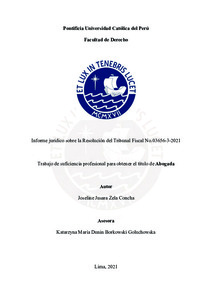| dc.contributor.advisor | Dunin-Borkowski Goluchowska, Katarzyna María | |
| dc.contributor.author | Zela Concha, Joseline Jusara | |
| dc.date.accessioned | 2022-02-11T23:47:16Z | |
| dc.date.available | 2022-02-11T23:47:16Z | |
| dc.date.created | 2021 | |
| dc.date.issued | 2022-02-11 | |
| dc.identifier.uri | http://hdl.handle.net/20.500.12404/21611 | |
| dc.description.abstract | En el presente informe se analiza la problemática vinculada a la prescripción de la
facultad de solicitar la devolución de las percepciones del IGV, sobre la base de la
determinación de la naturaleza de dichas percepciones.
Una postura señala que las percepciones del IGV tienen la naturaleza de pago en exceso
por lo que el computo de la prescripción se realizará en virtud del nacimiento de la
obligación tributaria del IGV, esto es mes a mes. En consecuencia, el plazo de
prescripción para solicitar su devolución se computa desde el 1 de enero del año siguiente
a la fecha en que se produce el nacimiento mensual del crédito por pago en exceso, sin
considerar el saldo acumulado de las percepciones.
Una segunda postura, la que se defiende en el presente informe, señala que las
percepciones del IGV tienen la naturaleza de pago anticipado, y, por lo tanto, constituyen
un crédito distinto al pago en exceso. Este crédito se genera en virtud del “saldo
acumulado” de percepciones no aplicadas del último periodo vencido y, cuando
transcurren como mínimo 3 periodos consecutivos sin aplicar dichas percepciones. En
ese sentido, el plazo de prescripción para solicitar su devolución empieza a computarse
desde el 1 de enero del año siguiente a la fecha en que terminan de transcurrir esos tres
meses. | es_ES |
| dc.description.abstract | This paper analyzes the problematic of the limitation period of the faculty to request the
return of the VAT perceptions, based on the determination of the nature of said
perceptions.
In this sense, one position indicates that the VAT perceptions have the nature of
overpayment, so the calculation of the limitation period will be carried out by virtue of
the birth of the VAT obligation, that is, month by month. Consequently, the statute of the
limitation period is computed from January 1 of the year following the date on which the
monthly credit for overpayment occurs, without considering the accumulated balance of
the perceptions.
A second position, the one defended in this paper, indicates that the VAT perceptions
have the nature of prepayment, and, therefore, constitute a different credit to the
overpayment. This credit is generated by the “accumulated balance” of unused
perceptions for the last expired period and when at least 3 consecutive periods have
elapsed without applying. In this sense, the limitation period begins to run from January
1 of the year following the date on which these three months end. | es_ES |
| dc.language.iso | spa | es_ES |
| dc.publisher | Pontificia Universidad Católica del Perú | es_ES |
| dc.rights | info:eu-repo/semantics/closedAccess | es_ES |
| dc.subject | Impuesto general a las ventas--Legislación--Perú | es_ES |
| dc.subject | Créditos tributarios--Legislación--Perú | es_ES |
| dc.subject | Perú--Legislación | es_ES |
| dc.title | Informe jurídico sobre la Resolución del Tribunal Fiscal No.03656-3-2021 | es_ES |
| dc.type | info:eu-repo/semantics/bachelorThesis | es_ES |
| thesis.degree.name | Abogado | es_ES |
| thesis.degree.level | Título Profesional | es_ES |
| thesis.degree.grantor | Pontificia Universidad Católica del Perú. Facultad de Derecho. | es_ES |
| thesis.degree.discipline | Derecho | es_ES |
| renati.advisor.dni | 7884910 | |
| renati.advisor.orcid | https://orcid.org/0000-0002-2016-7292 | es_ES |
| renati.author.dni | 70463350 | |
| renati.discipline | 215106 | es_ES |
| renati.juror | Sotelo Castañeda, Eduardo Jose | es_ES |
| renati.juror | Sevillano Chavez, Sandra Mariela | es_ES |
| renati.level | https://purl.org/pe-repo/renati/level#tituloProfesional | es_ES |
| renati.type | https://purl.org/pe-repo/renati/type#trabajoDeSuficienciaProfesional | es_ES |
| dc.publisher.country | PE | es_ES |
| dc.subject.ocde | https://purl.org/pe-repo/ocde/ford#5.05.01 | |





